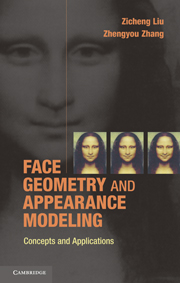5 - Shape modeling from images
from PART II - FACE MODELING
Published online by Cambridge University Press: 01 June 2011
Summary
Image-based face modeling techniques can be divided into two categories depending on whether they model the illumination effects or not. The techniques in the first category do not model illumination, and they have origins from structure from motion or stereovision. The techniques that belong to the second category model the illumination effects, and their origins can be traced to shape from shading. In this chapter, we describe techniques that belong to the first category. The techniques the belong to the second category will be introduced in Chapter 7.
The techniques that belong to the first category in general require two or more views. If the corresponding camera motions are not known, that is, the cameras are not calibrated, it becomes a structure from motion problem. If the camera motions are known, it becomes a stereovision problem. We will describe structure from motion approaches in Section 5.1, and stereovision approaches in Section 5.2. After that, we will discuss two special situations: face modeling from two orthogonal views and face modeling from a single view.
Structure from motion approach
Given two or more views of a face and assuming that the camera motions (or head poses) corresponding to the views are not known, we would like to estimate the face geometry. The general idea is to find corner matchings across different views and then estimate the camera motion and face geometry.
- Type
- Chapter
- Information
- Face Geometry and Appearance ModelingConcepts and Applications, pp. 48 - 85Publisher: Cambridge University PressPrint publication year: 2011



